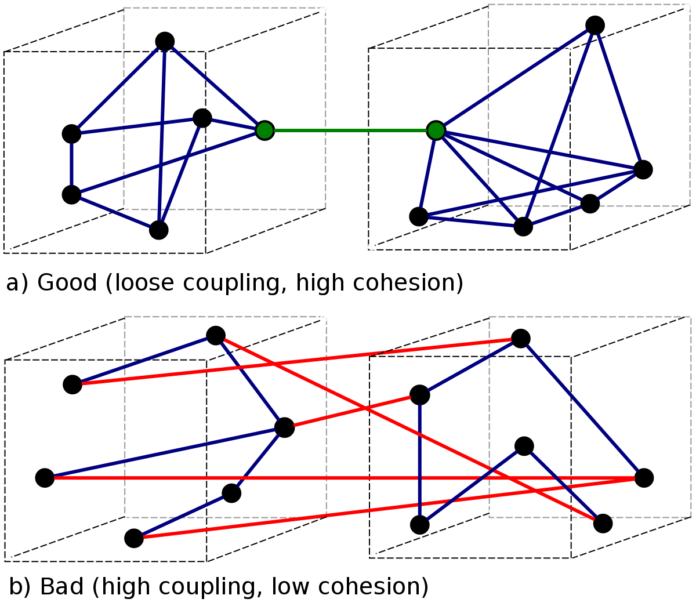Coupling is the degree of interdependence between software modules; a measure of how closely connected two routines or modules are; the strength of the relationships between modules. Coupling is usually contrast with cohesion. Low coupling often correlates with high cohesion, and vice versa.
Low coupling is often thought to be a sign of a well-structured computer system and a good design, and when combined with high cohesion, supports the general goals of high readability and maintainability.
The software quality metrics of coupling and cohesion were invented by Larry Constantine in the late 1960s as part of a structured design, based on characteristics of “good” programming practices that reduced maintenance and modification costs. Structured design, including cohesion and coupling, were published in the article Stevens, Myers & Constantine (1974) and the book Yourdon & Constantine (1979), and the latter subsequently became standard terms.
Whether loosely or tightly couple, a system’s performance is often reduce by message and parameter creation, transmission, translation (e.g. marshaling) and message interpretation (which might a reference to a string, array or data structure), which require less overhead than creating a complicate message such as a SOAP message. Longer messages require more CPU and memory to produce. To optimize runtime performance, message length must minimize and message meaning must maximize.
What is the need of coupling?
Coupling shows the relationships between modules. Cohesion shows the relationship within the module. It shows the relative independence between the modules. Cohesion shows the module’s relative functional strength. While creating, you should aim for low coupling, i.e., dependency among modules should be less.
What are advantages of coupling?
Coupling is usually contrast with cohesion. Low couple often correlates with high cohesion, and vice versa. Low couple is often to a sign of a well-structure computer system and a good design, and when combine with high cohesion, supports the general goals of high readability and maintainability.
What are disadvantages of coupling?
- A change in one module usually forces a ripple effect of changes in other modules.
- Assembly of modules might require more effort and/or time due to the increased inter-module dependency.
- A particular module might be harder to reuse and/or test because dependent modules must be included.
Is coupling bad in programming?
In general, Tight Coupling is bad in but most of the time, because it reduces flexibility and re-usability of code, it makes changes much more difficult, it impedes test ability etc. loose couple is a better choice because A loosely couple will help you when your application need to change or grow.
How do you avoid coupling in code?
- The only way to do it otherwise is to pass in just the int score as a parameter; but then you’ve got the problem that you can pass in any int, not just one which is semantically a Candidate ‘s score.
- There’s not really any difference.
How do you get a loose coupling?
The general way to achieve loose couple is through well define interfaces. If the interaction between two systems is well define and adhere to on both sides, then it becomes easier to modify one system while ensuring that the conventions are not break.
Why inheritance is tightly coupled?
Whereas inheritance derives one class from another, composition defines a class as the sum of its parts. Classes and objects created through inheritance are tightly couple because changing the parent or superclass in an inheritance relationship risks breaking your code.
What is a coupling process?
A reaction in organic chemistry is a general term for a variety of reactions where two fragments are join together with the aid of a metal catalyst. Hetero-couplings combine two different partners, such as in the Heck reaction of an alkene (RC=CH) and an alkyl halide (R’-X) to give a substituted alkene.
How do I know my coupling size?
- Place the inside tips of the caliper on the inside of the bowl
- Expand the tips of the caliper until they’re fully extend to the bowl size.
- This will give you the correct size of the bowl needed.
- 1.75 is equivalent to a 1 3/4 size bowl.





